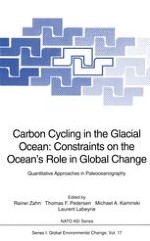1994 | OriginalPaper | Chapter
A Comparison of Carbon Isotopes and Cadmium in the Modern and Glacial Maximum Ocean: Can We Account for the Discrepancies?
Author : Edward A. Boyle
Published in: Carbon Cycling in the Glacial Ocean: Constraints on the Ocean’s Role in Global Change
Publisher: Springer Berlin Heidelberg
Included in: Professional Book Archive
Activate our intelligent search to find suitable subject content or patents.
Select sections of text to find matching patents with Artificial Intelligence. powered by
Select sections of text to find additional relevant content using AI-assisted search. powered by
Oceanic cadmium, carbon isotopes, phosphorus, and dissolved carbon dioxide are correlated on a global scale because of the dominance of the biological cycling of these elements. Some differences between the distributions of these properties are seen in the modern ocean, although these differences can be rationalized. In the glacial maximum (18K) ocean, the differences between benthic foraminiferal δ13C and Cd/Ca are much larger than in the modern ocean, suggesting quite different scenarios for the carbon system chemistry of the Southern Ocean, the northwest Pacific Ocean, and the intermediate waters of the Pacific. A reexamination of the modern distribution of δ13C and Cd suggests that one major factor which has not been addressed in detail is the role of gas exchange on δ13C, but it is not clear that this factor can reconcile the differences between the tracers during the glacial maximum. The modern oceanic Cd-P relationship is reassessed in light of three new data sets and found to be consistent with previous interpretations of deep ocean data. The issue of foraminiferal accuracy and precision for δ13C and Cd/Ca reconstructions is considered: more effort on living benthic foraminifera is clearly needed to resolve the uncertainties concerning foraminiferal response to bottom water properties.
